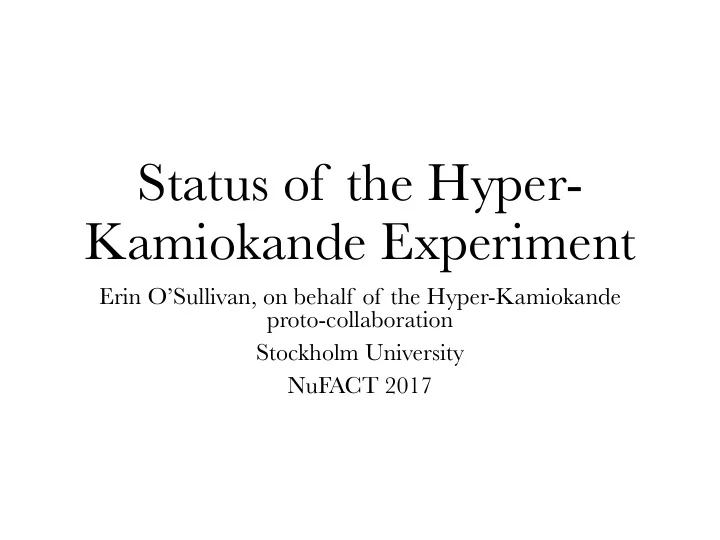

Status of the Hyper- Kamiokande Experiment Erin O’Sullivan, on behalf of the Hyper-Kamiokande proto-collaboration Stockholm University NuFACT 2017
Hyper-Kamiokande collaboration Proto-collaboration formed in 2015 ~ 300 members from 14 countries (71 institutes) 2
Hyper-Kamiokande detector Two 74m (D) x 60m (H) tanks Total (fiducial) volume of two tanks: 516 kT (374 kT). We are prioritizing the quick realization of the first tank, with a second tank to follow. Unless indicated, all plots in this talk show sensitivity with one tank. 3
Hyper-Kamiokande detector 4
Water Cherenkov technology Muon: sharp ring Electron: fuzzy ring 5
Hyper-Kamiokande site Detector will be located at the Tochibora Mine site 8 km south of SK Overburden of 1,750 mwe 6
HK phototubes HK baseline design: box and line (SK uses venetian blind) Twice the detection efficiency, better timing and charge resolution 7
HK phototube development Covers to protect against pressure Multi-PMT option (adapted are being developed from KM3NeT design) being explored 8
HK construction timeline Data taking expected in 2026 9
T2HK 295 km Hyper-K detector (Kamioka) J-PARC neutrino Beam (Tokai) Building off the successful T2K program, Hyper-K also plans to measure neutrinos from the J-PARC neutrino beam 10
J-PARC beam – Planned upgrade Plans to upgrade main ring would increase J- PARC beam power to ~1.3MW Upgrades will mean 3x more beam power by 2026 (in time for Hyper-K) 11
See Mathieu Lamoureaux’s talk tomorrow in the WG1+WG2 session at 11:30 Near Detector – Planned upgrade 12
See Cris Vilea’s talk tomorrow in the WG1+WG2 session at 11:30 1 kton E61 Intermediate Detector (1 km away) 13
Hyper-Kamiokande Physics Goals As Astr trop ophysical 14
See Christophe Bronner’s talk today in the WG1 session at 14:48 Neutrino oscillation parameters High precision oscillation parameter measurement: 15
Octant determination: Using accelerator neutrinos 16
CP violation measurement Looking for differences in the oscillation behaviour between neutrinos and anti-neutrinos 17
CP violation measurement: Using accelerator neutrinos (known hierarchy) (known hierarchy) Year After 10 years of running, HK will be able to measure ~50% of the 𝛆 CP space to better than 5 𝜏 18
Mass hierarchy 10 years of running, atmospheric-only Combined accelerator+atmospheric Normal Normal Inverted Inverted Depending on 𝛊 23 , mass hierarchy can be determined with √ 𝚬𝛙 2 between 4 and 6 19
Octant determination: Adding atmospheric neutrinos 10 years of running, atmospheric-only Combined atmospheric+accelerator Normal Inverted For sin 2 𝛊 23 =0.45: beam alone ~4 𝛕 , atmospheric alone ~2 𝛕 , beam+atmospheric ~5-6 𝛕 20
CP violation measurement: Resolving parameter degeneracies by adding atmospheric neutrinos (unknown hierarchy) 21
Nucleon decay Flagship nucleon decay modes: p → e + 𝝆 0 p → 𝝽 K + Limits will be improved across all nucleon decay channels, some by an order of magnitude. 22
Solar neutrinos Solar upturn sensitivity Measuring the transition region 3.5 MeV threshold 4.5 MeV threshold Solar upturn Hyper-K can measure the solar upturn to ~5 𝜏 (3 𝜏 ) after 10 years with 3.5 MeV (4.5 MeV) threshold 23
Solar neutrinos Measuring the hep neutrino Small energy region above 8 B neutrinos Good energy resolution and high statistics means Hyper-K will have sensitivity to hep solar neutrinos 24
Supernova neutrinos What would a galactic (10kpc) supernova look like in Hyper-K? Timing information Energy information 25
Supernova neutrinos Seeing distant supernovae with Hyper-K 26
See arXiv:1611.06118 [hep-ex] HK-K Exploring option of putting second HK tank in Korea Signal at Korea Signal at Japan Putting the second detector at the second oscillation maximum means our signal has a different shape → makes us less sensitive to systematic errors 27
Two detectors in Japan T2HKK Second detector in Korea, two colours for two different candidate sites The second detector in Korea allows us to better measure the CP-phase, compared with both detectors in Japan 28
HK Status • In summer 2017, HK was listed as a top project on the Ministry of Education, Culture, Sports, Science and Technology (MEXT) roadmap with the highest possible rating of (a,a) • A budget request to the Japanese funding agency has been submitted • Many opportunities for new collaborators to make an impact - please join us! 29
Summary • Hyper-K will be a world-leading water Cherenkov experiment • Good prospects for detecting CP-violation, oscillation parameters, and mass hierarchy with accelerator and atmospheric neutrinos • Non-accelerator physics goals include nucleon decay and astrophysical neutrinos • Placing the second HK tank in Korea could enhance our sensitivity to our physics goals, including CP-violation. 30
31
Recommend
More recommend